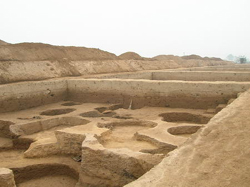
Chinese archaeologists have reaped a huge harvest in 2005, with
a large number of significant discoveries reported over the past
year.
At the "Archaeology Forum" which opened on Tuesday, Liu Qingzhu,
director of the Institute of Archaeology under the Chinese Academy
of Social Sciences (CASS), said that the new discoveries ranging
from the paleolithic age to the Ming Dynasty (1368-1644).
The discoveries have not only helped resolve many academic
questions, but also pointed toward new directions of future
research, said Liu.
Archaeologists showed their recent findings at the forum,
including a prehistoric site in Mentougou District in Beijing, a
neolithic site in Hongjiang City in Central China's Hunan Province,
and an ancient tomb dated back to the Western Zhou Dynasty (1100
BC-771 BC) in North China's Shanxi Province.
A kind of mysterious mound grave excavated in East China's Jiangsu
Province, a tomb dated back to the bronze age in Northwest China's
Xinjiang Uygur Autonomous Region, and a gate of the 2,000-year-old
Daming Palace in Northwest China's Shaanxi Province were also
introduced by their discoverers at the forum.
Bai Yunxiang, deputy director of the Institute of Archaeology,
said Chinese archaeologists have clearer academic goals in their
excavation and research, and archaeological methods have been
improved greatly.
More modern technologies have been applied in archaeological
research, and the protection of cultural relics was highlighted
during excavation, Bai said.
The annual forum, sponsored by the CASS, was launched in 2001 to
offer a stage for Chinese archaeologists to exchange their new
discoveries and promote archaeological development.
?
(Xinhua News Agency January 11, 2006)

